The first time I heard about Thai drunken noodles was a few years ago, when I visited a Thai restaurant that my son was doing a part time job during his university day.
Little did I know that the noodles are not cooked with alcohol but a spicy dish with plenty of chilies and basil until recently.
No one knows how the name ‘drunken noodles’ was coined, but it is one of the most popular Thai street foods worldwide.
I will show you how to prepare these spicy noodles in this article. This dish may be easier to prepare than you think and is highly adaptable.
The authentic recipe is incredibly spicy. I have halved the number of chilies in this recipe.
Let’s get into the detail.
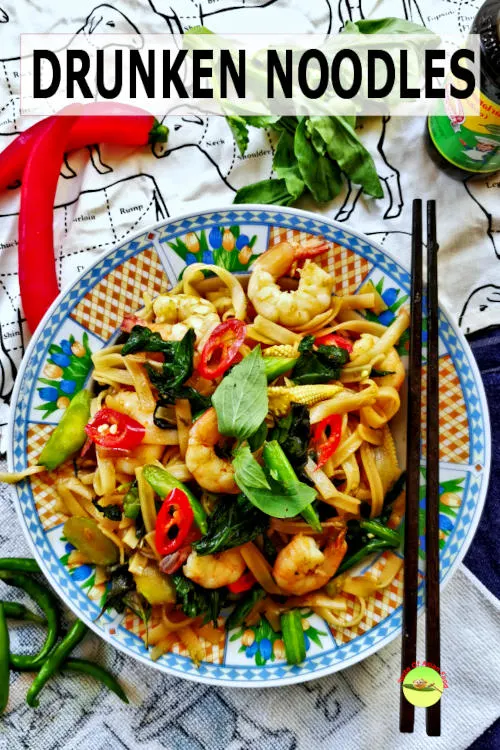
Note: This post may contain affiliate links. Please read my privacy policy for more info. I may receive commissions for purchases made through links in this post. As an Amazon Associate, I earn from qualifying purchases.
What are drunken noodles?
Drunken noodles are called ผัดขี้เมา in Thai, which is translated as phad kee mao, pad kee mow and pad khi mao. The origin of the name is obscured. Since ‘khi mao’ means drunkard, the theory is that the noodles are so hot and spicy that the man has to drink so much to quench his thirst until drunk. Another story said a drunkard cooked the noodles in the kitchen with a massive amount of chili.
How to make drunken noodles
You will get different versions of drunken noodles on the menu in various Thai restaurants. Since it is a highly flexible recipe, they will serve you either chicken, beef, or vegetarian drunken noodles.
This recipe is based loosely on the authentic Thai recipe, using Chinese broccoli (gai lan), bird’s eye chili, and Thai basil. I am lucky to live in Malaysia, which shares its border with Thailand and with a larger Thai population. As a result, I can get most of the Thai ingredients easily.
Here is a detailed explanation of how to prepare the Thai drunken noodles.
1. Ingredients for making drunken noodles
a. The Thai flat rice noodles
Flat rice noodles are used to prepared drunken noodles. There are two types of noodles you can use. The first one is the fresh rice noodles commonly used in Thailand but may be hard to get in other countries. The second type is more frequently found in the supermarket, which is in the dried form.
I use the dried noodles in this recipe since the fresh noodles are not available. These noodles are labeled as rice sticks suitable for preparing drunken noodles, pad see ew, and phad Thai.
The fresh noodles are soft, which is suitable to stir-fry directly. Some fresh noodles have already cut into strips, and others are in a sheet, which you have to cut to the width you want.
The dried noodles are hard, and you have to rehydrate them. Please follow the instruction on the packaging. If there is no instruction given, soak them in boiling water for about ten minutes to rehydrate and soften them. Unlike pasta, you only need to soak rather than boiling them in water.
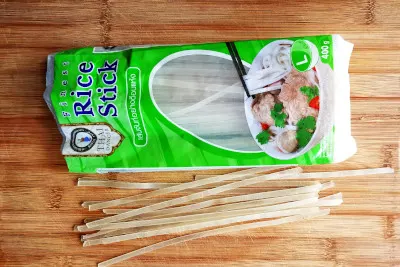
b. The chilies
There are two types of chiles I used to prepare drunken noodles.
The first type is the large red chilies popular for making curries and other South East Asian dishes. It is primarily for decorative purposes.
The second type is a much smaller species, which is called bird’s eye chili. These chilies come in two colors, red and green. I used the green one as I already using the large red chili. These chilies are much hotter than the bigger type and provide hotness and flavor to the noodles.
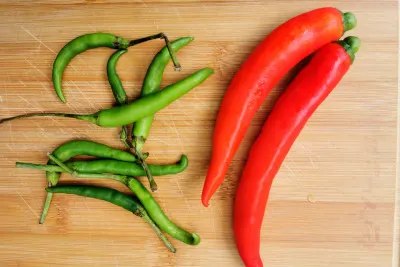
c. The protein (meat, shrimp, etc.)
You can exclude meat or seafood from the recipe since the main ingredients for drunken noodles are flat rice noodles, chilies, and basil. However, chicken is still the most common ingredient due to its universal appeal and popularity. Beef and shrimp drunken noodles are also very popular besides chicken. You can also omit the meat and seafood to make it a vegetarian-friendly dish.
d. The vegetables
Basil is the essential vegetable for drunken noodles, and therefore this dish is sometimes referred to as Thai basil noodles. It is the flavor of the basil that sets it apart from pad Thai and pad see ew. I use Thai basil for my recipe as it is widely available here. You can also use holy basil and other species as an alternative.
Besides the basil, you can use any vegetables of your choice to stir fry the noodles. I use Chinese broccoli (gai lan) in this recipe as it is the most commonly used vegetable for the noodles.
Besides the Chinese broccoli, onion, scallion, baby corn, red bell peppers, regular broccoli, zucchini, and carrot are all suitable to prepare drunken noodles.

e. The seasonings
The seasoning for drunken noodles is a mixture of some everyday items. Since you can use the mixture of these ingredients for other stir-fries, you may consider preparing a batch of this ‘drunken noodle sauce’ and reserve it for other Thai dishes.
The main seasonings are light soy sauce, dark soy sauce, oyster sauce, fish sauce, the Golden Mountain seasoning, and some sugar.
It is best to buy the made in Thailand ingredients. However, there are times when it might not be viable. For example, I cook Chinese food regularly, and I know that Thai and Chinese light soy sauce taste almost identical. In this case, it is not practical to purchase a bottle of Thai light soy sauce for only one Thai dish.
The Golden Mountain seasoning is a Thai product, but you can substitute it with Maggi seasoning, widely available in other countries.
There are different types of dark soy sauce available. Some brands are darker and sweeter than others. Since the purpose of dark soy sauce is mainly to add some color to the stir-fried noodles, you need to adjust the amount to get the desired color you want.
Fish sauce is irreplaceable, and there is no substitute. You have to forgo it (and also oyster sauce) for the vegetarian drunken noodles and use more soy sauce instead to get the desired flavor.
As for the sugar, you can use either brown or regular sugar.
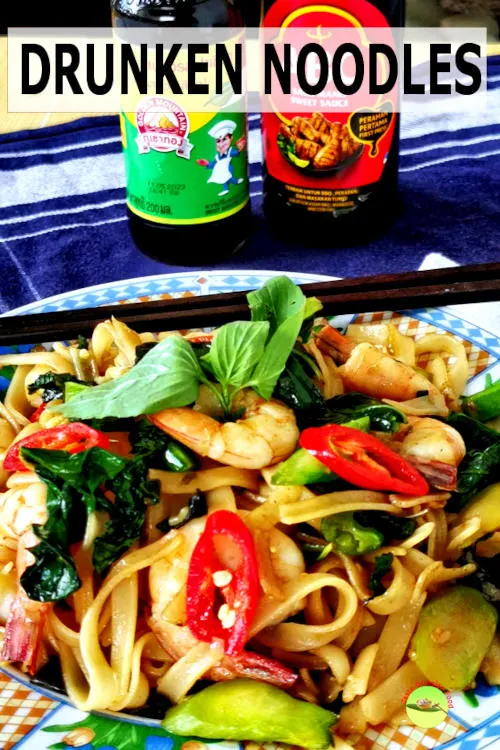
2. Step-by-step guide – how to cook Thai’s drunken noodles
Here is my step-by-step explanation on how to prepare the drunken noodles in detail.
a. Preparation of the ingredients
- Place the dried flat rice noodles in a pot of boiling water. Soak them in hot water for ten minutes or until they are soft and translucent. The time required depends on the thickness and size of the noodles. Usually, it will take about ten minutes.
- Once they are soft, drain off the water and set it aside.
- Cut the chicken thigh meat into one-inch length pieces. Marinate it with some light soy sauce and cornstarch for fifteen minutes. (Detail is in the recipe below).
- Remove the stem of the bird’s eye chilies and cut them into small sections. Place them into a mortar with a few cloves of garlic and crush them into a paste. The number of chilies is flexible as it depends on the spiciness you can handle. The result is different by using the mortar and pestle compare to chopping the chilies. Grinding the chilies with mortar and pestle breaks the pulp and the seeds, effectively releasing the flavor. The chilies will remain as small pieces if you chop them, and the flavor is less intense.
- Peel off the fibrous surface of the broccoli stem. Cut the Chinese broccoli into two inches sections.
- Slice each baby corn on the bias into three sections.
- Cut a large red chili into thin rings and remove the seeds. The red chilis are mainly for garnishing.
- Measure all the seasonings as stated in the recipe to keep things flowing smoothly at stir-fry time. It is more practical to constitute a ‘drunken noodles sauce’ with these ingredients before stir-frying.
- Clean the basil and set it aside. We will use the leaves only later.
b. The stir-frying process
Start with low heat
- Heat a large scoop of oil in a well-seasoned wok. Swirl the oil around to coat the entire surface of the wok. Remove the extra oil and store it in a container. You might have seen those chefs in the Asian kitchen performing this step, as it is an effective way to prevent any food morsels from sticking to the wok during stir-frying.
- Let the remaining oil in the wok cools down a bit before adding the garlic and chili paste, as the garlic can burn quickly.
- Saute the garlic and chili until aromatic, which takes less than a minute.
- Add the chicken thigh meat and stir-fry over low to medium heat until it starts to turn color. The chicken will stick to the wok easily if you start with high heat since it is marinated with cornstarch. Once it turns color, increase the heat gradually to medium and continue stir-frying until nearly cooked.
- Add the Chinese broccoli and baby corns to the wok. Continue stir-frying over medium heat until the broccoli leaves are wilted, and the stems become soft.
- Add the noodles to the wok. The noodles might stick together after keeping them aside for some time. You can loosen the noodles by adding some water to them, then drain away with a colander.
Note: If you use shrimp instead of chicken, stir-fry the shrimp separately and only combine with the noodles right before adding the basil leaves. We do not want to overcook the shrimp.
End with high heat
- Add all the seasoning to the wok. Now you have all the ingredients in it except the red chili slices and the basil leaves.
- Turn the heat to high gradually while stir-frying the noodles to combine all the ingredients.
- I use a high-power gas stove to fry the noodles over roaring heat in the last part of stir-frying, as shown in the video. HIgh heat generates the wok aroma, the signature flavor of a stir-frying dish.
- What if you do not have a high-power stove? Stir fry the noodles in small batches, preferably not larger than half the amount as in the video. Keep the heat as high as possible to generate a sufficient wok aroma. A small stove cannot produce sufficient heat to create the wok aroma for a large noodles batch.
- Once you can smell the wok aroma and the noodles are well-combined with the seasonings, turn off the heat, and add the basil leaves and sliced red chilies. The remaining heat in the wok is enough to cook the basil. When all the leaves are wilted, transfer the noodles to the serving plate to serve immediately.
Related recipes to drunken noodles
If you like drunken noodles, you will be most likely also interested in the following related Thai dishes:
Pad Thai is a stir-fried rice noodle dish similar to drunken noodles but uses dried shrimps, groundnuts, sweet preserved radish, and bean sprouts as the main ingredients.
Pad see ew is the non-spicy version of drunken noodles. Try this recipe if you can’t take the heat of the fiercely hot bird’s eye chili in drunken noodles.
Not all Thai foods are spicy, and pandan leaf chicken is one of them. Pandan chicken is a specialty dish with a refreshing pandan aroma encased in the leaf packets.

Thai Drunken Noodles
I had an impression that Thai’s drunken noodles are an alcoholic dish until recently.
Instead, the noodles are not cooked with alcohol, but a spicy dish with plenty of chilies and basil.
No one knows how the name was coined, but it is one of the most popular Thai street foods worldwide.
Ingredients
Ingredients A
- 4 cloves of garlic
- 2 birk’s eye chili (or more)
Ingredients B
- 200g chicken thigh meat
- 2 tsp soy sauce
- 1 tsp cornstarch
Ingredients C
- 6 baby corns
- 1 large stalk of gai lan
Ingredients D
- 1 tbsp oyster sauce
- 2 tsp light soy sauce
- 2 tsp Golden Mountain seasoning
- 1 tsp fish sauce
- 2 tsp dark soy sauce
- 2 tsp brown sugar
Ingredients E
- 200g flat rice noodles (dry weight)
- 1 large handful of basil leaves
- 1 large red chili
Instructions
Preparation
- Soak the dried noodles in hot water for ten minutes or until they are soft and translucent. Drain and set it aside.
- Cut the chicken thigh meat into one-inch length pieces. Marinate with B for fifteen minutes.
- Place the bird’s eye chilies and garlic into a mortar and grind them into a paste.
- Peel off the fibrous surface of the Chinese broccoli stem. Cut them into one to two inches sections.
- Slice each baby corns on the bias into three sections.
- Cut a large red chili into thin rings and remove the seeds.
- Clean the basil and use the leaves only.
Stir-frying
- Heat some oil over low heat in the wok. Saute the garlic and chili until aromatic, which will take less than a minute.
- Add the chicken thigh meat and stir-fry over low to medium heat until it starts to turn color.
- Add the Chinese broccoli and baby corns to the wok. Continue stir-frying until the stem of the vegetable become soft.
- Add the noodles to the wok.
- Add all the seasoning D to the wok.
- Stir-fry over high heat until you can smell the wok aroma.
- Turn off the heat, and add the basil leaves and sliced red chilies. When all the leaves are wilted, transfer the noodles to the serving plate to serve immediately.
Recommended Products
As an Amazon Associate and member of other affiliate programs, I earn from qualifying purchases.
Nutrition Information:
Yield: 3 Serving Size: 1Amount Per Serving: Calories: 825Total Fat: 41gSaturated Fat: 13gTrans Fat: 0gUnsaturated Fat: 19gCholesterol: 182mgSodium: 4080mgCarbohydrates: 62gFiber: 6gSugar: 10gProtein: 57g
This data was provided and calculated by Nutritionix on 3/4/2021


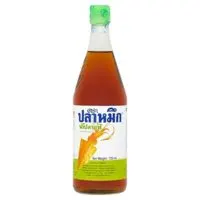

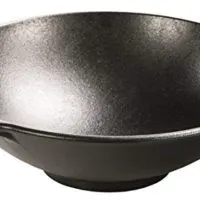
Stephen
Sunday 8th of January 2023
Hello, What is birk’s eye chili?
KP Kwan
Sunday 8th of January 2023
Bird's eye chili, also known as Thai chili or Thai dragon, is a small, thin chili pepper that is very spicy. It is called "bird's eye" chili because it is about the size of a bird's eye. The chili is native to Thailand and commonly used in Thai and Southeast Asian cuisine. It has a sharp, pungent flavor and is often used to heat dishes. The chili is also used medicinally, as it is believed to have several health benefits due to its high content of capsaicin, which gives chili peppers their heat.
Robert Taylor
Saturday 6th of March 2021
I am really glad you have these shown in video. I also like the fact that you offer different ingredients because many are not available in my small town.
KP Kwan
Saturday 6th of March 2021
Thank you, and I hope you will love these noodles.
Julie
Friday 5th of March 2021
I followed the instructions and ingredients. Really yummy! I like spicy so I added red chilli padi
KP Kwan
Friday 5th of March 2021
Hi, this is KP Kwan. I am happy to see you in this comment area, as you have read through my recipe. I am pleased to reply to any questions and comments as soon as possible.